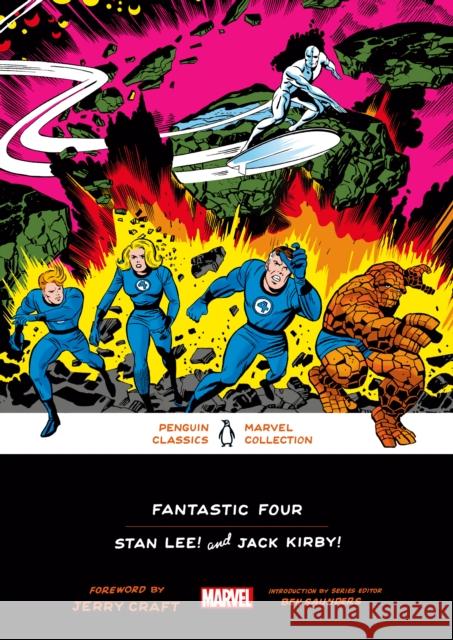Fantastic Four » książka



(netto: 101,36 VAT: 5%)
Najniższa cena z 30 dni: 106,13
ok. 16-18 dni roboczych
Dostawa w 2026 r.
Darmowa dostawa!
A groundbreaking example of comics representation in literature.
Publishers Weekly
Penguin provides introductory essays; superb analyses by the series editor, Ben Saunders; and extensive bibliographies.
Michael Dirda, The Washington Post
Stories become classics when generations of readers sort through them, talk about them, imitate them, and recommend them. In this case, baby boomers read them when they débuted, Gen X-ers grew up with their sequels, and millennials encountered them through Marvel movies. Each generation of fans initially fanboys, increasingly fangirls, and these days nonbinary fans, too found new ways not just to read the comics but to use them. That s how canons form. Amateurs and professionals, over decades, come to something like consensus about which books matter and why or else they love to argue about it, and we get to follow the arguments. Canons rise and fall, gain works and lose others, when one generation of people with the power to publish, teach, and edit diverges from the one before ... A top-flight comic by Kirby or his successor on Captain America, Jim Steranko barely needed words. You could follow the story just by watching the characters act and react. Thankfully, Penguin volumes do justice to these images. They reproduce sixties comics in bright, flat, colorful inks on thick white paper unlike the dot-based process used on old newsprint, but perhaps truer to their bold, thrill-chasing spirit.
Stephanie Burt, The New Yorker
As before, all three of these volumes re-present Professor Ben Saunders learned general series intro which does an excellent job of succinctly explaining the rise of Marvel Comics and the Marvel Method.
Forces of Geek
Writer-editor Stan Lee (1922 2018) and artist Jack Kirby made comic book history in 1961 with The Fantastic Four #1. The success of its new style inspired Lee and his many collaborators to develop a number of Super Heroes, including, with Jack Kirby, the Incredible Hulk and the X Men; with Steve Ditko, the Amazing Spider-Man and Doctor Strange; and with Bill Everett, Daredevil. Lee oversaw the adventures of these creations for more than a decade before handing over the editorial reins at Marvel to others and focusing on developing Marvel s properties in other media. For the remainder of his long life, he continued to serve as a creative figurehead at Marvel and as an ambassador for the comics medium as a whole. In his final years, Lee s signature cameo appearances in Marvel s films established him as one of the world s most famous faces.
Born Jacob Kurtzberg in 1917 to Jewish-Austrian parents on New York s Lower East Side, Jack Kirby came of age at the birth of the American comic book industry. Horrified by the rise of Nazism, Kirby co created the patriotic hero Captain America with Joe Simon in 1940. Cap s exploits on the comic book page entertained millions of American readers at home and inspired US troops fighting the enemy abroad. Kirby s partnership with Simon continued throughout the 1940s and early 50s; together, they produced comics in every popular genre, from Western to romance. In 1958, Kirby began his equally fruitful collaboration with writer- editor Stan Lee, and in 1961 the two men co created the foundational text of the modern Marvel Universe: The Fantastic Four. Over the next decade, Kirby and Lee would introduce a mind- boggling array of new characters including the Avengers, the Hulk, Thor, Iron Man, the Silver Surfer, and the X Men. Kirby s groundbreaking work with Lee formed the foundation of the Marvel Universe. In the early 1970s, Kirby moved to DC Comics, where he created his interconnected Fourth World series, as well as freestanding titles such as The Demon. He returned to Marvel in 1975, writing and illustrating The Black Panther and Captain America, and introducing series such as Devil Dinosaur, and The Eternals. Kirby died in 1994. Today, he is generally regarded as one of the most important and influential creators in the history of American comics. His work has inspired multiple generations of writers, artists, designers, and filmmakers, who continue to explore his vast universe of concepts and characters. He was an inaugural inductee into the Eisner Hall of Fame in 1987.
Ben Saunders is a professor of English at the University of Oregon. He is the author of Desiring Donne: Poetry, Sexuality, Interpretation and Do the Gods Wear Capes?: Spirituality, Fantasy, and Superheroes, as well as numerous critical essays on subjects ranging from the writings of Shakespeare to the recordings of Little Richard. He has also curated several museum exhibitions of comics art, including the record- breaking, multimedia touring show Marvel: Universe of Super Heroes a retrospective exploring the artistic and cultural impact of Marvel Comics from 1939 to the present.
Jerry Craft is the New York Times bestselling author and illustrator of the graphic novels New Kid and Class Act. New Kid is the winner of the 2020 John Newbery Medal for the most outstanding contribution to children s literature. In addition, New Kid was awarded the Kirkus Prize for Young Readers Literature. He is also the recipient of the Coretta Scott King Author Award for the most outstanding work by an African American writer.
1997-2025 DolnySlask.com Agencja Internetowa
KrainaKsiazek.PL - Księgarnia Internetowa









